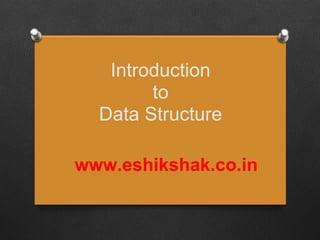Melden
Teilen
Downloaden Sie, um offline zu lesen

Empfohlen
Empfohlen
Weitere ähnliche Inhalte
Ähnlich wie Introduction of data_structure
Ähnlich wie Introduction of data_structure (20)
Algorithm 110801105245-phpapp01-120223065724-phpapp02

Algorithm 110801105245-phpapp01-120223065724-phpapp02
Algorithms-Flowcharts-Data-Types-and-Pseudocodes.pptx

Algorithms-Flowcharts-Data-Types-and-Pseudocodes.pptx
Architecting and productionising data science applications at scale

Architecting and productionising data science applications at scale
Mehr von eShikshak
Mehr von eShikshak (20)
Mesics lecture 7 iteration and repetitive executions

Mesics lecture 7 iteration and repetitive executions
Mesics lecture 6 control statement = if -else if__else

Mesics lecture 6 control statement = if -else if__else
Kürzlich hochgeladen
Kürzlich hochgeladen (20)
HMCS Max Bernays Pre-Deployment Brief (May 2024).pptx

HMCS Max Bernays Pre-Deployment Brief (May 2024).pptx
ICT Role in 21st Century Education & its Challenges.pptx

ICT Role in 21st Century Education & its Challenges.pptx
Python Notes for mca i year students osmania university.docx

Python Notes for mca i year students osmania university.docx
General Principles of Intellectual Property: Concepts of Intellectual Proper...

General Principles of Intellectual Property: Concepts of Intellectual Proper...
This PowerPoint helps students to consider the concept of infinity.

This PowerPoint helps students to consider the concept of infinity.
Beyond_Borders_Understanding_Anime_and_Manga_Fandom_A_Comprehensive_Audience_...

Beyond_Borders_Understanding_Anime_and_Manga_Fandom_A_Comprehensive_Audience_...
UGC NET Paper 1 Mathematical Reasoning & Aptitude.pdf

UGC NET Paper 1 Mathematical Reasoning & Aptitude.pdf
Sensory_Experience_and_Emotional_Resonance_in_Gabriel_Okaras_The_Piano_and_Th...

Sensory_Experience_and_Emotional_Resonance_in_Gabriel_Okaras_The_Piano_and_Th...
HMCS Vancouver Pre-Deployment Brief - May 2024 (Web Version).pptx

HMCS Vancouver Pre-Deployment Brief - May 2024 (Web Version).pptx
Introduction of data_structure
- 1. Introduction to Data Structure www.eshikshak.co.in
- 2. Algorithm ● An algorithm is a finite set of instructions which, when followed, accomplishes a particular task. ● Its Characteristics ○ Each instruction should be unique and concise ○ Each instruction should be relative in nature and should not be repeated infinitely. ○ Repetition of same task(s) should be avoided. ○ The result be available to the user after the algorithm terminates. www.eshikshak.co.in
- 3. Efficiency of Algorithms ● The performance of algorithms can be measured on the scales ● Time ● Space www.eshikshak.co.in
- 4. Space Complexity ● The amount of memory space required by the algorithm during the course of execution ● Some of the reasons for space complexity are ○ If the program, is to run on mutli-user system, it may be required to specify the amount of memory to be allocated to the program ○ We may be interested to know in advance that whether sufficient memory is available to run the program. ○ There may be several possible solutions with different space requirements. www.eshikshak.co.in
- 5. Space needed by Program Components ● Instruction Space – Space needed to store the executable version of the program and it is fixed. ● Data Space : It is needed to store all constants, varialbe values ● Environment Space : Space needed to store the information needed to resume the suspended functions. www.eshikshak.co.in
- 6. Time Complexity ● The amount of time needed to run to completion. ● Some reasons for studying time complexity ○ We may be interested to know in advance that whether a program will provide satisfactory real time response. ○ There must be several possible solutions with different time requirements. www.eshikshak.co.in
- 7. Data structure ● When elements of data are organized together in terms of some relationships among the elements, the organization is called data structure. ● A data structure is a set of data values along with the relationship between the data values in form of set of operations permitted on them. ● Arrays, records, stacks, lists, graphs are the names of some of some of these basic data structures. www.eshikshak.co.in
- 8. A data structure can be (a) transient i.e. it is created when a program starts and is destroyed when the program ends. Most data structures in main memory are transient, for example, an array of data. (b) Permanent i.e. it already exists when a program starts and is preserved when the program ends. Most data structures on disk are permanent, for example, a file of data, or a cross- linked data file collection (a database). www.eshikshak.co.in
- 9. Data Structure Linear Non-Linear ● Array ● Tree ● Stack ● Graph ● Queue ● Linked Lists www.eshikshak.co.in
- 10. Abstract Data Type (ADT) ● It is a mathematical model with a collections of operations defined on that model. ● The ADT encapsulates a data type can be localized and are not visible to the users of the ADT. ● An implementation of an ADT is a translation into statements of a programming language, of the declaration that defines a variable to be of that ADT, plus a procedure in that language for each operation of the ADT. www.eshikshak.co.in
